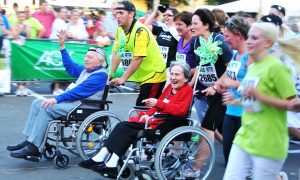 Health and Fitness
Health and Fitness
Fitness Through the Ages
By Cheryl Alker
Physical fitness is one of the most important factors that influence longevity in life, However, the exercise that was suitable for a 20 year old would not then apply to a 60 year old. So what factors should you be taking into account as far as your physical fitness goals as you age?
The first priority lies, no doubt, with your parents. Developing physical fitness habits as early in life as possible paves the way for better health in later life. Getting children involved in team and individual sports has so many benefits that it should literally never be up for debate. Finding their passion is key and that passion normally will be developed when they find something they are good at.
So what happens after childhood when high school or travel sports are no longer an option?
20s
During your 20’s your body is most susceptible to change, so it is during this period that rapid progress can be made in both strength and cardiovascular endurance. Workouts should be kept to a whole body approach working on all the elements of physical fitness, muscular strength, muscular endurance, cardiovascular fitness and flexibility. Take care of all of these factors with a sensible diet and your Body Mass Index (BMI) should take care of itself.
30s
During your 30’s you will begin to notice that you don’t achieve progress as easily as you did during your 20’s and injuries may start to arise. Whilst you should still maintain a high level of physical activity with a full body approach time needs to also be dedicated to recovering sufficiently to avoid injuries and burnout. Start to include regular massages into your workout plan and introduce a little less impact with cardio workouts.
40s
Our 40’s are often accompanied by many extra obligations. Our profession, family life, finances, home ownership etc. can place a huge strain on our time. Consequently, less time is dedicated to physical fitness and all to often our diet suffers also. Problems such as high blood pressure, chronic stress, depression or cardiovascular disease make beginning and maintaining regular physical activity even more crucial at this time in our life. Keeping cardiovascular exercises to low impact alternatives and focus more on free weights as opposed to machines so muscles are worked through full range incorporating all muscle groups involved in the action. This is a time to focus heavily on flexibility and core strength to provide mobility, stabilization and prevention of back pain.
50s
At this stage in your life you may need to begin to modify the type of exercise you choose to accommodate for physical limitations. For example, if you have been a lifelong runner, you may be unable to run as frequently as you used to or indeed be able to manage the longer distances. Not because the mind is weak, but after 50 years or so on this earth your joints will have started to show some wear and tear, especially if you were a road runner. This not only applies to runners but any sport that has been done for a number of years will undoubtedly result in wear and tear due to repetitive movements. This is the time to find a new primary exercise with less impact, maybe swimming, yoga, or pilates. If you focused on your flexibility in your 40’s your 50 year old body will thank you. As we age mobility is key, so flexibility is vital and should be given the respect is deserves.
60s
As you progress through your 60’s time needs to be dedicated to strength training. Strength is extremely important to overall health. The more muscle mass you maintain the more normal you hormone function and less energy will be needed to perform daily tasks. Equal strength between opposing muscle groups will maintain joint support and possibly help prevent injuries from events such as falls. Use your body weight for all strength based exercises and take up swimming, biking or walking to maintain cardiovascular health. Continue with flexibility and core strength exercises daily.
70s and Beyond
At this stage in your life the type of physical activity you chose takes back seat to the amount of daily activity you perform. Keeping moving is key here, sitting for long periods of time is your enemy. Having hobbies that involve movement, taking up tai chi or water based exercises are the way to go. Rule of thumb, just move!

